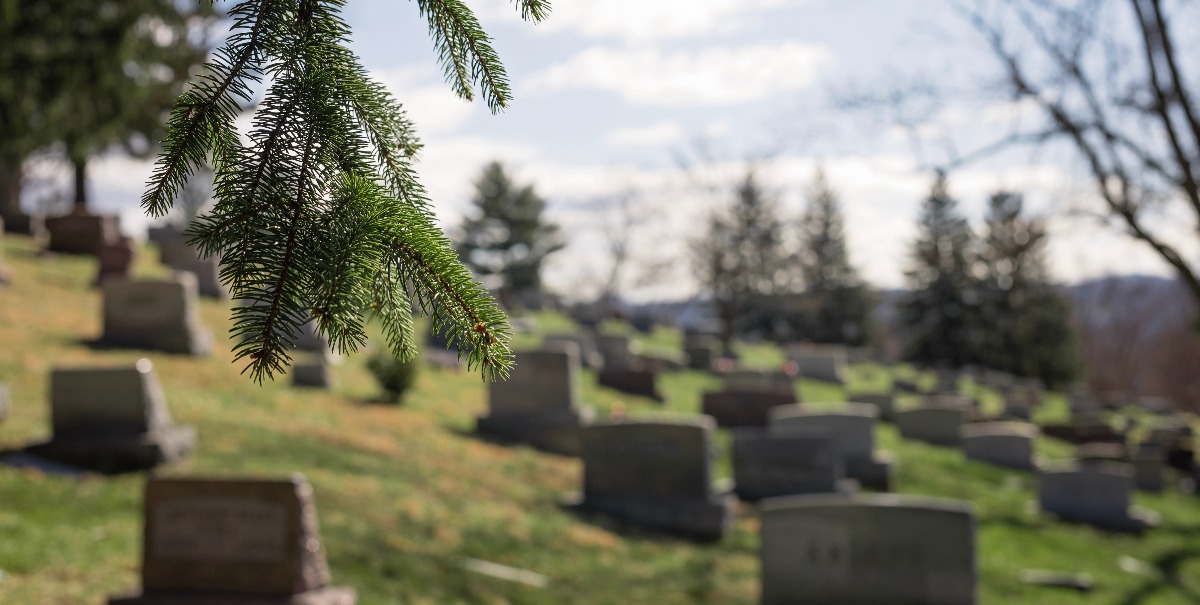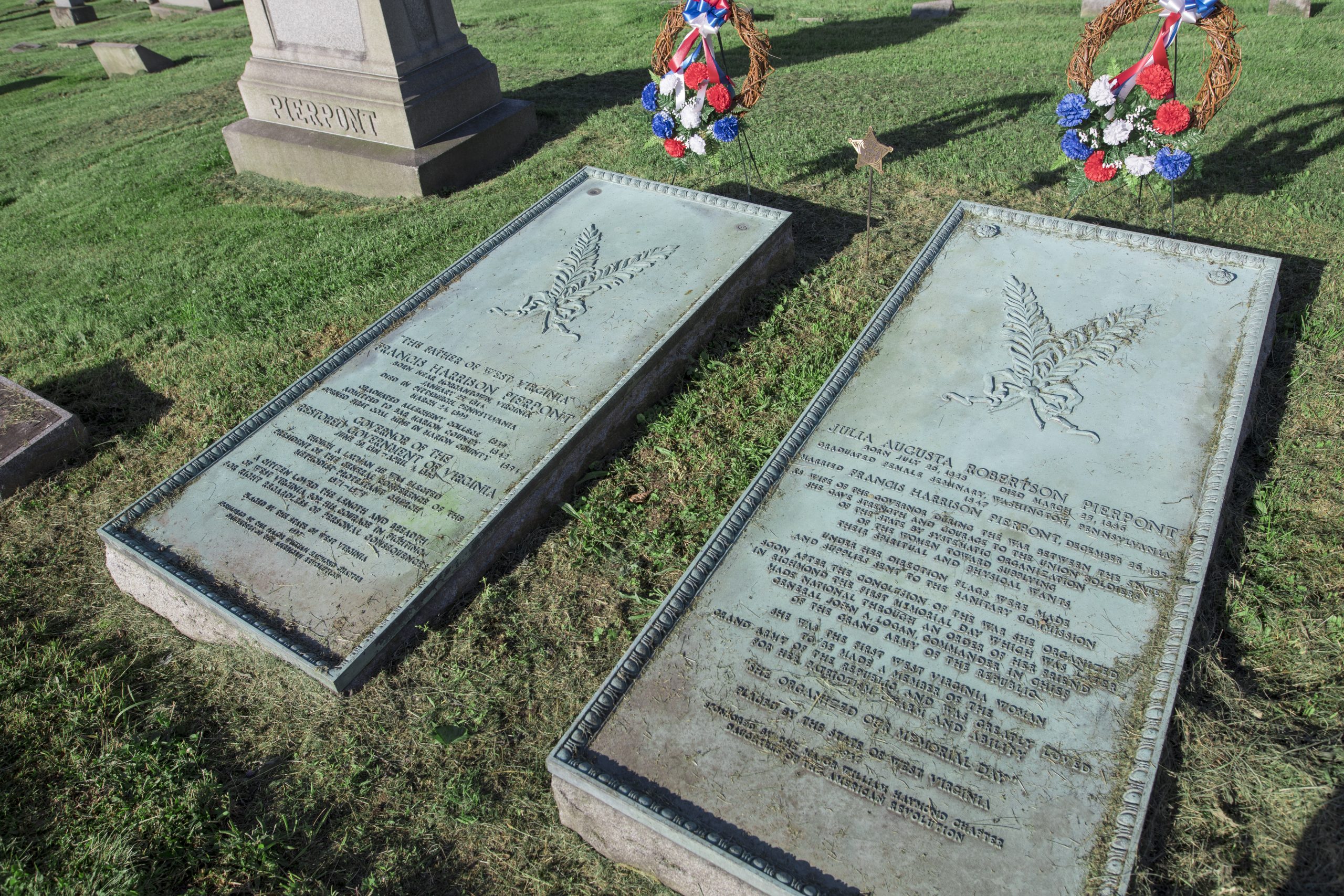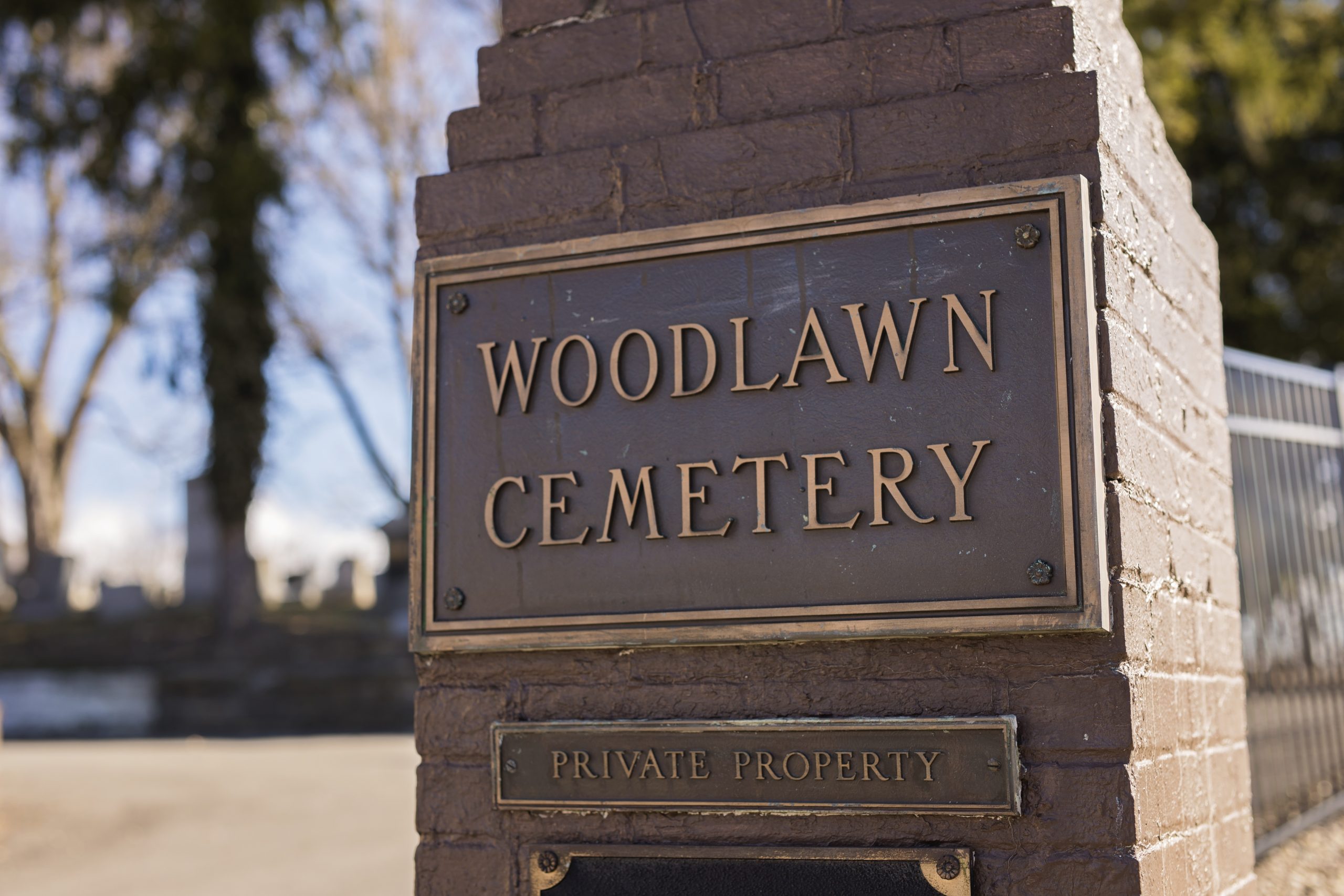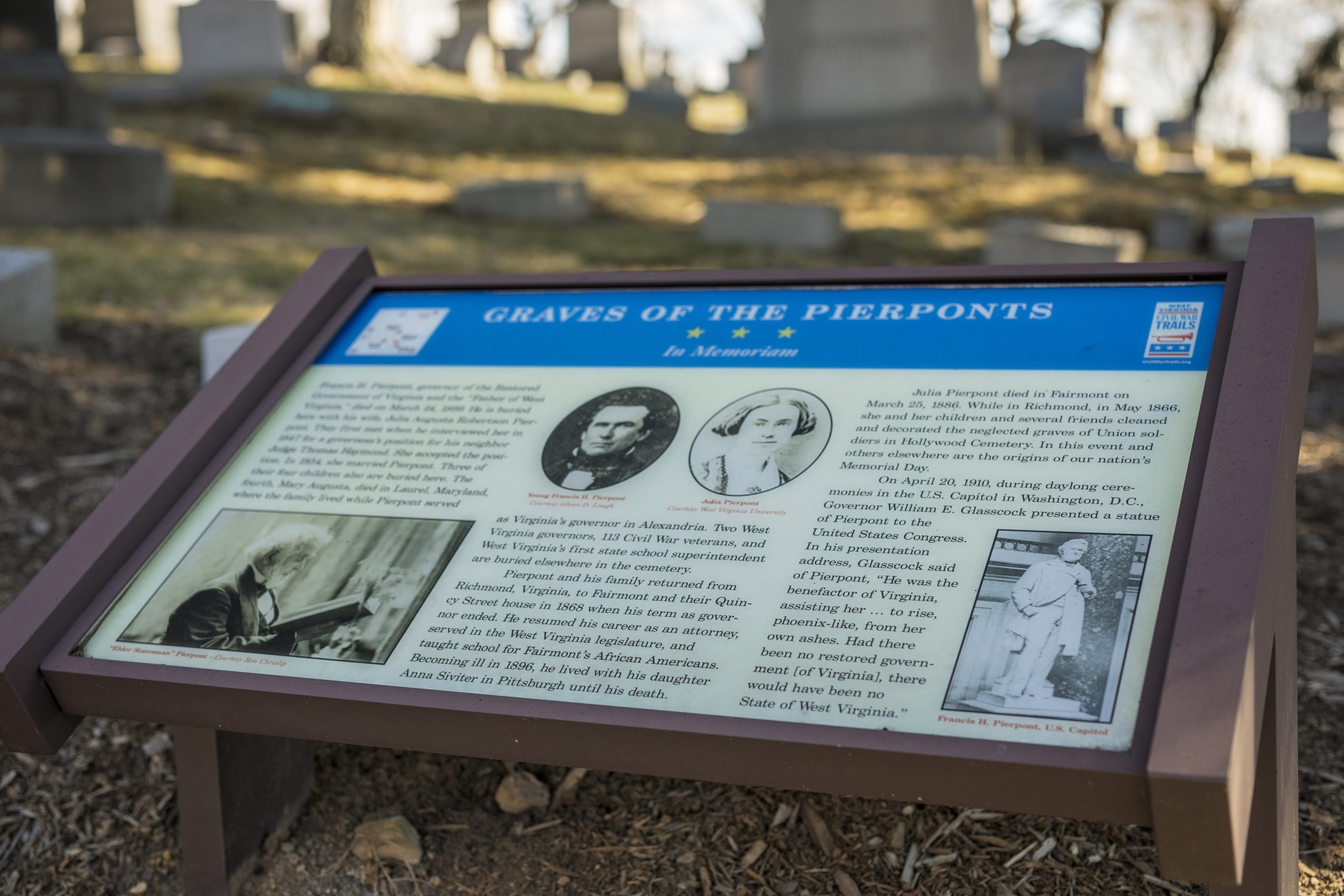Woodlawn Cemetery is the resting place for many of the people who made lasting contributions to Fairmont, the state of West Virginia, and our nation. The cemetery was established in the early spring of 1875. Ten years later, in December 1885, the Woodlawn Cemetery Company was incorporated and plots were offered for sale to the larger community.
Many of the early leaders of the Fairmont community were laid to rest at Woodlawn Cemetery. Among them are Francis H. Pierpont, the Governor of the Restored State of Virginia from 1861–1868, his wife Julia, and three of their four children. Additionally, Boaz Fleming, the founder of Fairmont, is buried here with his wife, Elizabeth.
Today, Woodlawn Cemetery covers 42 acres and holds over 15,000 graves. It is listed on the National Register of Historic Places.
History
Woodlawn Cemetery was established in the early spring of 1875. The story has it that Joseph R. Hamilton was climbing the fence between his father’s farm and that of Norval Barns. He was in the old sheep yard on the Elmus and Louisa Hamilton (early Marion County pioneers) property, the part of Middletown, now Fairmont. The loaded rifle he was carrying accidentally discharged, killing him. His father’s decision to “bury him where he lay” led to the families establishing a small burying ground. They opened the fence line between their properties and enclosed about a quarter of an acre to use for family burials.
Ten years later, in December 1885, the Woodlawn Cemetery Company was incorporated and plots were offered for sale to the larger community. Five acres were purchased from each of the landowners, Elmus Hamilton, and Norval Barns.
Designed by Tell W. Nicolet of the firm of Morris and Knowles of Pittsburgh, PA, Woodlawn is considered a rural cemetery. The rural cemetery or garden cemetery is a style of a cemetery that became popular in the United States and Europe in the mid-nineteenth century due to the overcrowding and health concerns of urban cemeteries. They were typically built one to five miles outside of the city, far enough to be separated from the city but close enough for visitors. They often contain elaborate monuments, memorials, and mausoleums in a landscaped park-like setting.
Rural Cemeteries
The rural cemetery movement mirrored changing attitudes toward death in the 19th-Century. Images of hope and immortality were popular in rural cemeteries in contrast to the puritanical pessimism depicted in earlier cemeteries. Statues and memorials included depictions of angels and cherubs as well as botanical motifs such as ivy representing memory, oak leaves for immortality, poppies for sleep, and acorns for life.
From their inception, they were intended as civic institutions designed for public use. Before the widespread development of public parks, the rural cemetery provided a place for the general public to enjoy outdoor recreation amidst art and sculpture previously available only for the wealthy.
Thoughts about rural cemeteries evolved toward the end of the 1800s due to the high cost of maintenance, development of true public parks, and perceived disorderliness of appearance due to independent ownership of family burial plots and different grave markers. Lawn cemeteries became instead an attractive design.
Community leaders
Many of the early leaders of the Fairmont community are laid to rest here. Among them is Francis Harrison Pierpont, the Governor of the Restored State of Virginia from 1861–1868, his wife Julia, and three of their four children. Additionally, Boaz Fleming, the founder of Fairmont, is here with his wife, Elizabeth. Other members of his family are here as well, including Clarissa Fleming Hamilton, his grandson Elmus Hamilton, owner of the Hamilton farm, and great-grandson, Joseph R. Hamilton. Another descendant is Aretas B. Fleming, eighth governor of West Virginia. A lawyer, Mr. Fleming was among the men who created the Fairmont Development Company and worked to develop Fairmont.
James Otis Watson is considered the father of the bituminous coal industry in north-central West Virginia. He and Pierpont owned the first coal mine to be commercially viable following the completion of the Baltimore and Ohio Railroad linking Fairmont with the eastern seaboard markets. One of his daughters married Aretas B. Fleming. His sons, James Edwin Watson, Sylvanus Lamb Watson, and Clarence Wayland Watson are also buried here.
A governor, a Congressman, and a national Senator are rolled into one in Matthew Mansfield Neely. Neely is the only West Virginian to serve in both houses of the Congress and as the Governor of West Virginia. He is also the only person to have held a full term in both Senate seats from the state. Neely was known through his political career as a master orator. In his honor, Fairmont State University sponsors an oratory contest in his name every year.
A Baseball Legend
Another area “celebrity” is buried at Woodlawn. Sam ‘Toothpick Sam’ Jones was a major league baseball player. For twelve seasons (1951 to 1952 and 1955 to 1964), he was a pitcher with Cleveland Indians, St. Louis Cardinals, Chicago Cubs, San Francisco Giants, Detroit Tigers, and Baltimore Orioles. He was nicknamed “toothpick” because he usually had one in his mouth while he pitched. Raised in West Virginia, he attended Dunbar High School and while serving with the United States Army Air Corps during World War II, Jones began to play baseball as a member of his camp’s team. Signed by the Indians as an amateur free agent in 1950, he marked his Major League debut with Cleveland in1951. He earned a place in the record books when he tossed a no-hit game against the Pittsburgh Pirates on May 12th, 1955 as a Chicago Cub. In 322 regular-season games, he compiled a 102 win 101 loss record with a 3.59 lifetime ERA in 1,643 innings pitched. After retiring as a player, he remained in the game as a Minor League coach. Jones died from lung cancer at the age of 45.
The number of burials in Woodlawn jumped between 1878 and 1879 when the graves of those buried in the Old Presbyterian Church Cemetery were reinterred in Woodlawn. The old church building was razed and a new church constructed at 301 Jackson Street in order to make way for an office building on the corner of Adams and Jefferson streets. Among those relocated graves were those of Boaz Fleming, the founding father of Middletown (Fairmont), and his wife.
Around 1892 there was a burst of excitement when excavations began for the Smith and McKinney building. An additional petrified body was discovered in the soil of the old cemetery. It laid there exposed for weeks, and people came from miles to see the sight. This last body was finally also moved to Woodlawn, although some of the petrified bones were said to be souvenirs of some people in the city.
Cemetery Care
It wasn’t until about 1930 that a group of realtors, spearheaded by Colonel A. Howard Fleming, a former Fairmont resident, came up with a plan to endow Woodlawn as a perpetual care cemetery. Colonel Fleming was a pallbearer at the very first funeral held in Woodlawn.
The realtors offered to sell the remaining 400 lots, and it was proposed at that time the cemetery be closed. (The cemetery did not close.) The realtors proposed that when the cemetery became endowed, “the care and upkeep would be perpetual and the graves would be kept in first-class condition. The roads will be under a perfect state of improvement; markers and monuments will be kept in position. This beautiful memorial park will be made and will be kept more beautiful…”
Stones dated 1814 indicate many stones predating the official establishment of the cemetery imply removals from other cemeteries and that this plot has been used as a burial ground from early pioneer days. Markers placed on the graves of Gov. and Mrs. F. H. Pierpont by the Hammond Chapter of DAR, also the graves of Peter Miller and Boaz Fleming, Revolutionary soldiers, have been marked by the DAR. Simon Shore, Sr., a soldier in the War of 1812, is buried here as is A. B. Fleming, Governor of the State of WV. A large monument erected by the Mead Circle, Ladies of the GAR near the grave of Governor Pierpont commemorates veterans of all American wars.
Caretaker’s Residence
The Chapel and Caretaker’s Residence is an important contributing structure in a national historic district. Built in 1928, the house was constructed using Hammond Fire Bricks of clay dug from the banks of the Tygart River at the site of present-day Valley Falls State Park. Construction was the result of community interest, effort, and donations.
The old Hammond Fire Brick Company of Marion County donated the bricks [clay mining was an important industry here for over 140 years and WV clay was especially prized due to the small size of its particles] while plumbers and electricians donated their work at cost. Local realtors sold lots to help finance constructions. The facility functioned until around 1980 as a mortuary chapel and as a caretaker’s residence and office.
In the fall of 2016 renovation began in phases. A new roof was added and window replacement began. Today windows have been replaced, the interior has been cleaned up and a few rooms are nearing completion. When finished this building will be a wonderful addition to Woodlawn and to our entire community.
Today Woodlawn covers 42 acres and holds over 15,000 graves. It is listed on the National Register of Historic Places as a historic district.




